Colorado Springs
What do these photos tell you about the different kind of stores and shops that were in those cities?
Drawing Of Pike's Peak- 1865
This is the future site of Colorado Springs. It shows Pikes Peak towering over the existing town of Colorado City. The drawing was made in 1865.
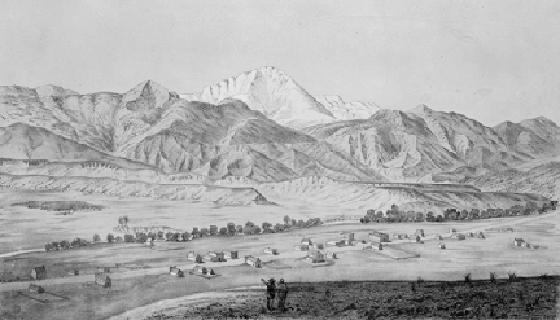
Photo: Denver Public Library, Western History Collection
More About This Topic
In 1871, William Jackson Palmer founded the town of Colorado Springs. He chose a beautiful place at the foot of the Rocky Mountains near Pikes Peak. Colorado Springs was located east of an older town called Colorado City.
Their Own Words
"After his first visit to this barren and arid plain, General Palmer wrote, “I am sure there will be a famous resort here soon after the railroad reaches Denver.” He bought the worthless tract of land and upon it he laid out a town with broad avenues and ample streets."
Source: Irving Howbert, Colorado Springs Telegraph, July 31, 1921.
William Jackson Palmer
This is William Jackson Palmer, the founder of Colorado Springs.
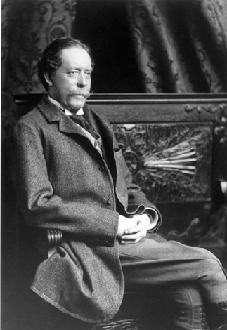
Photo: Denver Public Library, Western History Collection
More About This Topic
William Jackson Palmer was a Civil War General who became a railroad builder after the war. In 1871, he began building the Denver and Rio Grande Railroad south from Denver. He also bought land near Pikes Peak to build a town that he would call Colorado Springs. He wanted to make it a famous resort that would attract people from the eastern United States and from Europe. They would get there on the Denver and Rio Grande Railroad.
Their Own Words
"My theory for this place is that it should be made the most attractive place for homes in the West, a place for schools, colleges, science, first class newspapers, and everything that the above imply."
Source: William Jackson Palmer to William A. Bell quoted in Amanda M. Ellis, The Colorado Springs Story [No place, no date]: 9.
Palmer's Home- Glen Eyrie
This is William Jackson Palmer's house at Colorado Springs.
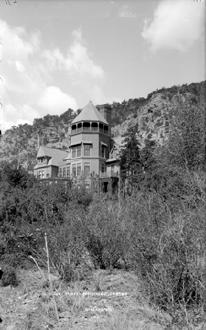
Photo: Denver Public Library, Western History Collection
More About This Topic
William Jackson Palmer built a fine mansion near Colorado Springs. It had three stories and a tower with a covered deck on top. It was located in a glen or valley west of town where eagles built their nests. He named the house Glen Eyrie. An eyrie is an eagle's nest.
Their Own Words
"I have been dreaming ever since…how the Castle should be on one of the bold, pine-topped hills near the mountain foot, and the farm-houses in the smooth, rounded valleys; how there should be fountains and lakes, and lovely drives and horse-back trails through groves-all planned and planted by ourselves."
Source: Frederick Jackson Palmer to Queen Mellon [his fiancé], quoted in Amanda M. Ellis, The Colorado Springs Story [No place, no date]: 6.
Cascade Avenue (facing South)
This is a view of Colorado Springs along Cascade Avenue, the tree-lined street on the right of the photo. The photo was taken in 1874.
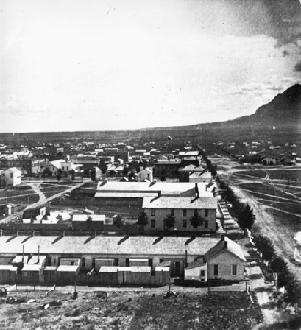
Photo: Denver Public Library, Western History Collection
More About This Topic
General Palmer’s new town grew rapidly. During the early 1870s, nearly 500 newcomers arrived each year. They built half that many house and buildings each year.
Their Own Words
"We reached Colorado Springs (the station) at noon, and found it situated on a perfectly flat, barren desert, but the fresh, new houses, wide streets and clear flowing streams in its gutters, causing the young trees to grow rapidly, the brilliant wild flowers blossoming profusely on the sidewalk and street, and the businesslike manner of the people, all combined to make one forget that it has grown up from a barren plain."
Source: Quoted in Susan Armitage, ed., “The Letters of Hester McClung,” Essays and Monographs in Colorado History, No. 5 (1987): 95.
Cascade Avenue (facing North)
This is a view of Colorado Springs in 1874 looking north along Cascade Avenue.
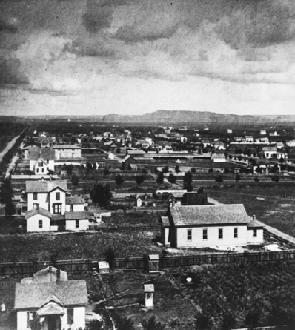
Photo: Denver Public Library, Western History Collection
More About This Topic
To help keep Colorado Springs shaded during the summer, Palmer had 5,000 cottonwood trees planted along the main streets.
Their Own Words
“You may imagine Colorado Springs, as I did, to be a [protected] valley with bubbling fountains, and green grass, and shady trees: but not a bit of it. Picture to yourself a level elevated plateau of greenish-brown without a single tree or plant larger than a Spanish bayonet (Yucca) two feet high, sloping down about a quarter of a mile to the railroad track . . . and you have a pretty good idea of the town-site as it appears in November 1871.”
“The streets and blocks are only market out by a furrow turned with the plough and indicated faintly by a wooden house, finished or in process of building, here and there, scattered over half a mile of prairie. About twelve shanties are inhabited, most of them being unfurnished, or run up for temporary occupation; and there are several tents dotted about also.”
Source: Rose Kingsley, quoted in Burt Allan Storey, William Jackson Palmer: Promoter,” Colorado Magazine, 43 (Winter 1966): 49.
Pike's Peak Avenue
This is a photo of the Antlers Hotel looking west toward Pikes Peak.
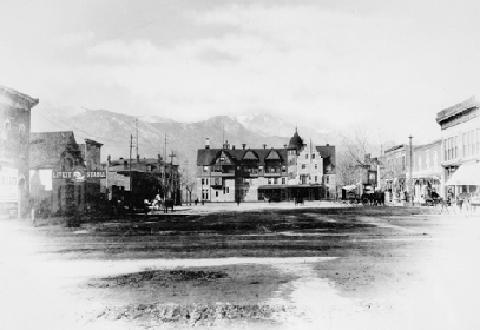
Photo: Denver Public Library, Western History Collection
More About This Topic
Colorado Springs was a tourist resort as well as a beautiful place to live. The Antlers Hotel on Pikes Peak Avenue was a popular hotel for tourists.
Their Own Words
"The Antlers is the foremost hotel of Colorado Springs and of the Rocky Mountain region. It is a thoroughly modern and strikingly handsome structure, complete and elegant in all its appointments, with a cuisine of noted excellence. Thousands of tourists from all parts of the world have pronounced it one of the most delightful hotels. Its rates range from $3 to $5 per day."
Source: Harper's Magazine Advertiser, 1892.
Cliff House Hotel
The hotel in this photo is Cliff House. It was located in Manitou Springs, a town five miles west of Colorado Springs.
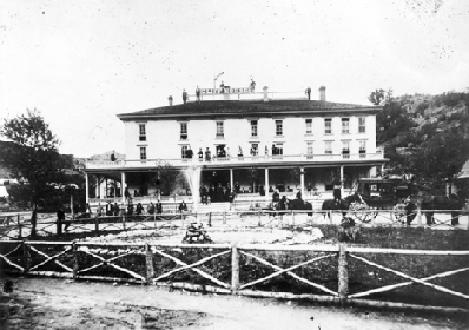
Photo: Denver Public Library, Western History Collection
More About This Topic
Just west of Colorado Springs is another resort town called Manitou Springs. It was famous for its mineral springs. Tourists stayed in hotels like Cliff House while they bathed in the mineral waters.
Their Own Words
"At Manitou we would stop to drink some of the mineral water for which I did not care in its virgin state. Provident folk took with them large glass bottles or jugs and filled them with water from soda springs. They had to be handled with care lest trouble ensue. If too full and subjected to a lot of motion, the jug was apt to blow its cork and the precious fluid lost. But my mother was careful and on our return we would have 'soda lemonade,' a great treat."
Source: Quantrille McClung, Memoirs of My Childhood and Youth in North Denver (Denver: Colorado Genealogical Society, 1979), p. 66.

